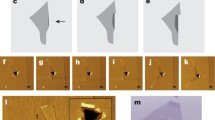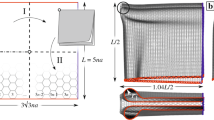Abstract
Understanding the underlying mechanism in the tearing and peeling processes of graphene is crucial for the further hierarchical design of origami-like folding and kirigami-like cutting of graphene. However, the complex effects among bending moduli, adhesion, interlayer interaction, and local crystal structure during origami-like folding and kirigami-like cutting remain unclear, resulting in challenges to the practical applications of existing theoretical and experimental findings as well as to potential manipulations of graphene in metamaterials and nanodevices. Toward this end, classical molecular dynamics (MD) simulations are performed with synergetic theoretical analysis to explore the tearing and peeling of self-folded graphene from a substrate driven by external force and by thermal activation. It is found that the elastic energy localized at the small folding ridge plays a significant role in the crack trajectory. Due to the extremely small bending modulus of monolayer graphene, its taper angle when pulled by an external force follows a scaling law distinct from that in case of bilayer graphene. With the increase in the initial width of the folding ridge, the self-folded graphene, motivated by thermal fluctuations, can be self-assembled by spontaneous self-tearing and peeling from a substrate. Simultaneously, the scaling law between the taper angle and adhesive energy is independent of the motivations for thermal activation-induced self-assembly and external force tearing, providing effective insights into the underlying physics for graphene-based origami-like folding and kirigami-like cutting.
Similar content being viewed by others
References
A. K. Geim and K. S. Novoselov, The rise of graphene, Nat. Mater. 6(3), 183 (2007)
A. C. Neto, F. Guinea, N. M. Peres, K. S. Novoselov, and A. K. Geim, The electronic properties of graphene, Rev. Mod. Phys. 81(1), 109 (2009)
R. Nair, H. Wu, P. Jayaram, I. Grigorieva, and A. Geim, Unimpeded permeation of water through helium-leak–tight graphene-based membranes, Science 335(6067), 442 (2012)
S. Hu, M. Lozada-Hidalgo, F. Wang, A. Mishchenko, F. Schedin, R. Nair, E. Hill, D. Boukhvalov, M. Katsnelson, R. Dryfe, I. V. Grigorieva, H. A. Wu, and A. K. Geim, Proton transport through one-atom-thick crystals, Nature 516(7530), 227 (2014)
R. Joshi, P. Carbone, F. C. Wang, V. G. Kravets, Y. Su, I. V. Grigorieva, H. Wu, A. K. Geim, and R. R. Nair, Precise and ultrafast molecular sieving through graphene oxide membranes, Science 343(6172), 752 (2014)
X. Liu, F. Wang, H. Wu, and W. Wang, Strengthening metal nanolaminates under shock compression through dual effect of strong and weak graphene interface, Appl. Phys. Lett. 104(23), 231901 (2014)
M. Yan, F. Wang, C. Han, X. Ma, X. Xu, Q. An, L. Xu, C. Niu, Y. Zhao, X. Tian, P. Hu, H. Wu, and L. Mai, Nanowire templated semihollow bicontinuous graphene scrolls: Designed construction, mechanism, and enhanced energy storage performance, J. Am. Chem. Soc. 135(48), 18176 (2013)
D. Akinwande, C. J. Brennan, J. S. Bunch, P. Egberts, J. R. Felts, H. Gao, R. Huang, J. S. Kim, T. Li, Y. Li, K. M. Liechti, N. Lu, H. S. Park, E. J. Reed, P. Wang, B. I. Yakobson, T. Zhang, Y. W. Zhang, Y. Zhou, and Y. Zhu, A review on mechanics and mechanical properties of 2D materials — Graphene and beyond, Extreme Mechanics Letters 13, 42 (2017)
V. Panchal, C. Giusca, A. Lartsev, R. Yakimova, and O. Kazakova, Local electric field screening in bi-layer graphene devices, Front. Phys. 2, 3 (2014)
G. Algara-Siller, O. Lehtinen, F. Wang, R. Nair, U. Kaiser, H. Wu, A. Geim, and I. Grigorieva, Square ice in graphene nanocapillaries, Nature 519(7544), 443 (2015)
Y. Zhu, F. Wang, J. Bai, X. C. Zeng, and H. Wu, Compression limit of two-dimensional water constrained in graphene nanocapillaries, ACS Nano 9(12), 12197 (2015)
H. Yin, H. J. Qi, F. Fan, T. Zhu, B. Wang, and Y. Wei, Griffith criterion for brittle fracture in graphene, Nano Lett. 15(3), 1918 (2015)
Z. Song, Y. Ni, and Z. Xu, Geometrical distortion leads to Griffith strength reduction in graphene membranes, Extreme Mechanics Letters 14, 31 (2017)
J. W. Jiang and H. S. Park, Negative Poisson’s ratio in single-layer graphene ribbons, Nano Lett. 16(4), 2657 (2016)
J. W. Jiang, T. Chang, X. Guo, and H. S. Park, Intrinsic negative Poisson’s ratio for single-layer graphene, Nano Lett. 16(8), 5286 (2016)
G. Wang, Z. Dai, Y. Wang, P. Tan, L. Liu, Z. Xu, Y. Wei, R. Huang, and Z. Zhang, Measuring interlayer shear stress in bilayer graphene, Phys. Rev. Lett. 119(3), 036101 (2017)
J. Annett and G. L. Cross, Self-assembly of graphene ribbons by spontaneous self-tearing and peeling from a substrate, Nature 535(7611), 271 (2016)
Y. Zhang, F. Zhang, Z. Yan, Q. Ma, X. Li, Y. Huang, and J. A. Rogers, Printing, folding and assembly methods for forming 3D mesostructures in advanced materials, Nature Reviews Materials 2(4), 17019 (2017)
X. Meng, M. Li, Z. Kang, X. Zhang, and J. Xiao, Mechanics of self-folding of single-layer graphene, J. Phys. D Appl. Phys. 46(5), 055308 (2013)
X. Chen, L. Zhang, Y. Zhao, X. Wang, and C. Ke, Graphene folding on flat substrates, J. Appl. Phys. 116(16), 164301 (2014)
X. Liu, F. Wang, and H. Wu, Anisotropic growth of buckling-driven wrinkles in graphene monolayer, Nanotechnology 26(6), 065701 (2015)
M. K. Blees, A. W. Barnard, P. A. Rose, S. P. Roberts, K. L. McGill, P. Y. Huang, A. R. Ruyack, J. W. Kevek, B. Kobrin, D. A. Muller, and P. L. McEuen, Graphene kirigami, Nature 524(7564), 204 (2015)
T. Zhang, S. Wu, R. Yang, and G. Zhang, Graphene: Nanostructure engineering and applications, Front. Phys. 12(1), 127206 (2017)
E. Hamm, P. Reis, M. LeBlanc, B. Roman, and E. Cerda, Tearing as a test for mechanical characterization of thin adhesive films, Nat. Mater. 7(5), 386 (2008)
E. Bayart, A. Boudaoud, and M. Adda-Bedia, Finitedistance singularities in the tearing of thin sheets, Phys. Rev. Lett. 106(19), 194301 (2011)
O. Kruglova, F. Brau, D. Villers, and P. Damman, How geometry controls the tearing of adhesive thin films on curved surfaces, Phys. Rev. Lett. 107(16), 164303 (2011)
F. Brau, Tearing of thin sheets: cracks interacting through an elastic ridge, Phys. Rev. E 90(6), 062406 (2014)
B. Roman, Fracture path in brittle thin sheets: a unifying review on tearing, Int. J. Fract. 182(2), 209 (2013)
A. Ibarra, B. Roman, and F. Melo, The tearing path in a thin anisotropic sheet from two pulling points: Wulff’s view, Soft Matter 12(27), 5979 (2016)
T. Zhang, X. Li, and H. Gao, Fracture of graphene: A review, Int. J. Fract. 196(1–2), 1 (2015)
M. J. Moura and M. Marder, Tearing of free-standing graphene, Phys. Rev. E 88(3), 032405 (2013)
Y. Guo, C. Liu, Q. Yin, C. Wei, S. Lin, T. B. Hoffman, Y. Zhao, J. H. Edgar, Q. Chen, S. P. Lau, J. Dai, H. Yao, H. S. Wong, and Y. Chai, Distinctive in-plane cleavage behaviors of two-dimensional layered materials, ACS Nano 10(9), 8980 (2016)
J. Yang, Y. Wang, Y. Li, H. Gao, Y. Chai, and H. Yao, Edge orientations of mechanically exfoliated anisotropic two-dimensional materials, J. Mech. Phys. Solids 112, 157 (2018)
D. Sen, K. S. Novoselov, P. M. Reis, and M. J. Buehler, Tearing graphene sheets from adhesive substrates produces tapered nanoribbons, Small 6(10), 1108 (2010)
A. F. Fonseca and D. S. Galvao, Self-driven graphene tearing and peeling: A fully atomistic molecular dynamics investigation, arXiv: 1801.05354 (2018)
S. Plimpton, Fast parallel algorithms for short-range molecular dynamics, J. Comput. Phys. 117(1), 1 (1995)
S. J. Stuart, A. B. Tutein, and J. A. Harrison, A reactive potential for hydrocarbons with intermolecular interactions, J. Chem. Phys. 112(14), 6472 (2000)
Y. Wei, J. Wu, H. Yin, X. Shi, R. Yang, and M. Dresselhaus, The nature of strength enhancement and weakening by pentagon-heptagon defects in graphene, Nat. Mater. 11(9), 759 (2012)
A. Stukowski, Visualization and analysis of atomistic simulation data with OVITO–the open visualization tool, Model. Simul. Mater. Sci. Eng. 18(1), 015012 (2010)
J. Zhang, J. Xiao, X. Meng, C. Monroe, Y. Huang, and J. M. Zuo, Free folding of suspended graphene sheets by random mechanical stimulation, Phys. Rev. Lett. 104(16), 166805 (2010)
T. Kawai, S. Okada, Y. Miyamoto, and H. Hiura, Selfredirection of tearing edges in graphene: Tight-binding molecular dynamics simulations, Phys. Rev. B 80(3), 033401 (2009)
B. Lawn, Fracture of Brittle Solids, Cambridge: Cambridge University Press, 1993
Y. Wang and Z. Liu, The fracture toughness of graphene during the tearing process, Model. Simul. Mater. Sci. Eng. 24(8), 085002 (2016)
Y. Y. Zhang and Y. Gu, Mechanical properties of graphene: Effects of layer number, temperature and isotope, Comput. Mater. Sci. 71, 197 (2013)
V. Hakim and A. Karma, Laws of crack motion and phase-field models of fracture, J. Mech. Phys. Solids 57(2), 342 (2009)
S. P. Koenig, N. G. Boddeti, M. L. Dunn, and J. S. Bunch, Ultrastrong adhesion of graphene membranes, Nat. Nanotechnol. 6(9), 543 (2011)
R. Huang, Graphene: Show of adhesive strength, Nat. Nanotechnol. 6(9), 537 (2011)
N. Lindahl, D. Midtvedt, J. Svensson, O. A. Nerushev, N. Lindvall, A. Isacsson, and E. E. Campbell, Determination of the bending rigidity of graphene via electrostatic actuation of buckled membranes, Nano Lett. 12(7), 3526 (2012)
Acknowledgements
This work was jointly supported by the Strategic Priority Research Program of the Chinese Academy of Sciences (Grant No. XDB22040402), the National Natural Science Foundation of China (Grant Nos. 11525211, 11472263, and 11572307), the Anhui Provincial Natural Science Foundation (Grant No. 1808085QA07), and the National Postdoctoral Program for Innovative Talents (Grant No. BX201700225). The authors declare no competing financial interest.
Author information
Authors and Affiliations
Corresponding author
Rights and permissions
About this article
Cite this article
He, ZZ., Zhu, YB. & Wu, HA. Self-folding mechanics of graphene tearing and peeling from a substrate. Front. Phys. 13, 138111 (2018). https://doi.org/10.1007/s11467-018-0755-5
Received:
Accepted:
Published:
DOI: https://doi.org/10.1007/s11467-018-0755-5




